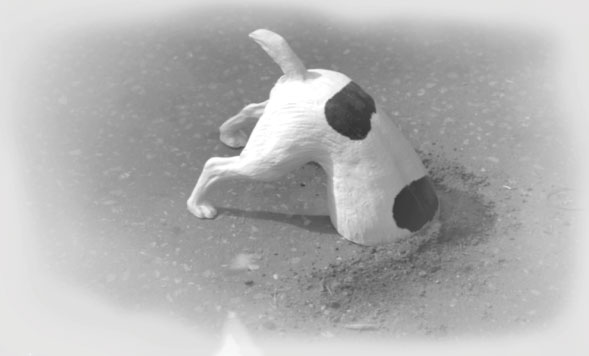|
By:
|
Help...My Dog Is Afraid of Storms
Does your pooch bury his head into your side every time it thunders out?
Does he dive under the bed whenever rain starts to fall.
From your point of view, this may seem like cute and endearing behavior, but it's a sign that your dog is terrified of storms. Some owners are willing to simply put up with symptoms of storm phobias like hiding, trembling, whining, drooling, and pacing. In more severe cases, however, panicking dogs have been known to chew furniture, tear drapes, break windows, and more during thunderstorms. In either case, the behavior is a sign of a terrified, unhappy dog.
Causes
Storm phobias are one of the most common behavioral problems dog owners face, but their cause is not entirely clear. Behaviorists are not yet sure what part of the storm frightens dogs most, whether they're reacting to lightning flashes, the sound of thunder, wind blowing around the house, or the sound of rain on the roof.
Some dogs even start to pace and whine half an hour or more before a storm. They may be reacting to a sudden drop in air pressure or the electrical charge of the air.
Nature or Nurture?
An article in the July/August 2001 issue of the Journal of the American Animal Hospital Association describes an Internet survey of the owners of storm-phobic dogs. The authors discovered that some breeds may be predisposed to a fear of storms.
Herding dogs, such as collies and German shepherds, and hounds, such as beagles and basset hounds, seem to be more likely to develop a storm phobia than other dogs. The phobia is also common in sporting and working breeds.
The study suggests that this tendency may be explained in terms of the dogs' genetics. For example, herding dogs have been bred to react quickly to stimuli, such as a calf wandering away from the herd, but not to be aggressive. It could be that herding dogs have a strong reaction to the startling noises and flashes of a storm, but they repress any aggressive response to it, causing anxiety.
The JAAHA study also showed that rescued dogs--dogs adopted from shelters or rescue organizations--may also be more likely to develop storm phobias. The article suggested that these dogs are more likely to have had unpleasant, scary experiences prior to being adopted. They may have been abused or abandoned by a former owner, or they may not have been well socialized or exposed to a wide variety of sights and sounds. These kinds of early-life experiences can make dogs more anxious and prone to all kinds of phobias.
What To Do
Your best bet for helping your pup overcome his thunderstorm fears is to talk to your veterinarian. He can help you develop a program to gradually retrain your scared-y dog by gradually, gently helping him adjust to storms through behavior modification.
Technically called "systematic desensitization," this involves exposing the storm-phobic dog to some gentle reminders of a thunderstorm, such as a very soft tape recording of thunder or a flashing light, and rewarding the dog with lots of treats, attention, and other positive reinforcement only if there's no evidence of anxiety.
Over time, the intensity of the stimulus is increased, and only calm behavior rewarded. You should get profession guidance, either from a veterinarian or a veterinary behavior specialist, before you begin this process, however. If you introduce frightening stimuli too quickly or don't see signs of fear your dog may be showing, you could possibly end up making the phobia worse.
If gentle, patient retraining doesn't help your pooch, there are some prescriptions that can. Your veterinarian can prescribe one of several anti-anxiety or antidepressant medications to help your dog remain calm during storms.
There are also natural supplements on the market that purport to have a calming effect on nervous or high-strung dogs. Products such as Pet Naturals of Vermontís Calming Formula are sold online and in pet specialty retail stores. They contain key herbal ingredients that can have a calming, soothing effect on your jittery pooch.
You can also make sure your dog has a warm, safe "den" to retreat to when the weather gets to scary. You can try padding a crate with blankets or clearing a space underneath your bed. Just make sure that it's somewhere your pup can get out of whenever he wants. A panicked dog can do a lot of damage to his crate and himself if he's confined.
Most important, though, is that your treat your dog gently and kindly when he is afraid. Don't cuddle and reassure him, because that will reward his scared-y-dog behavior, but definitely don't punish him for it either. Instead, just be calm and provide him with a safe, familiar place where he can feel secure and ride out the storm.
|
 |
|

|


